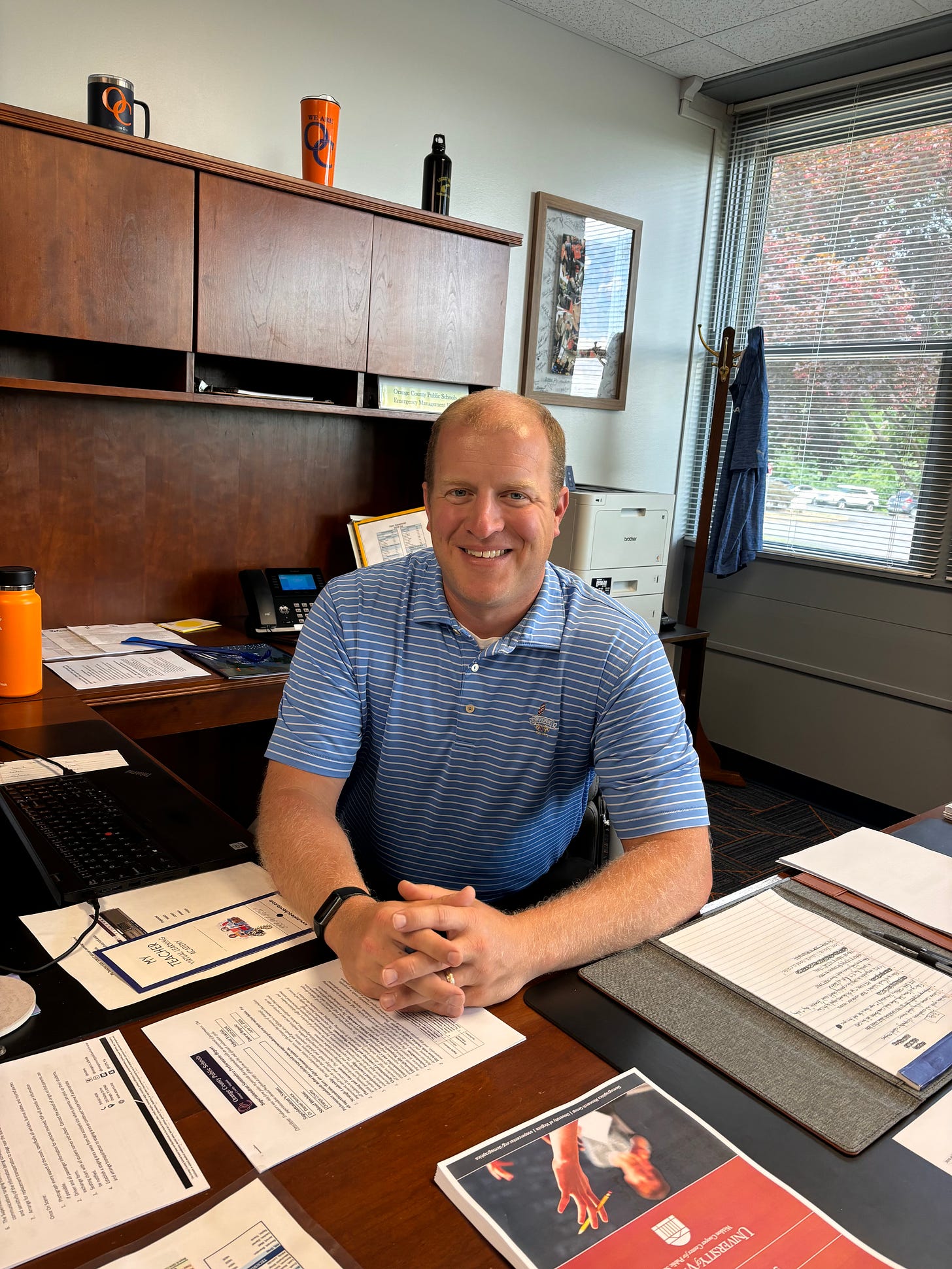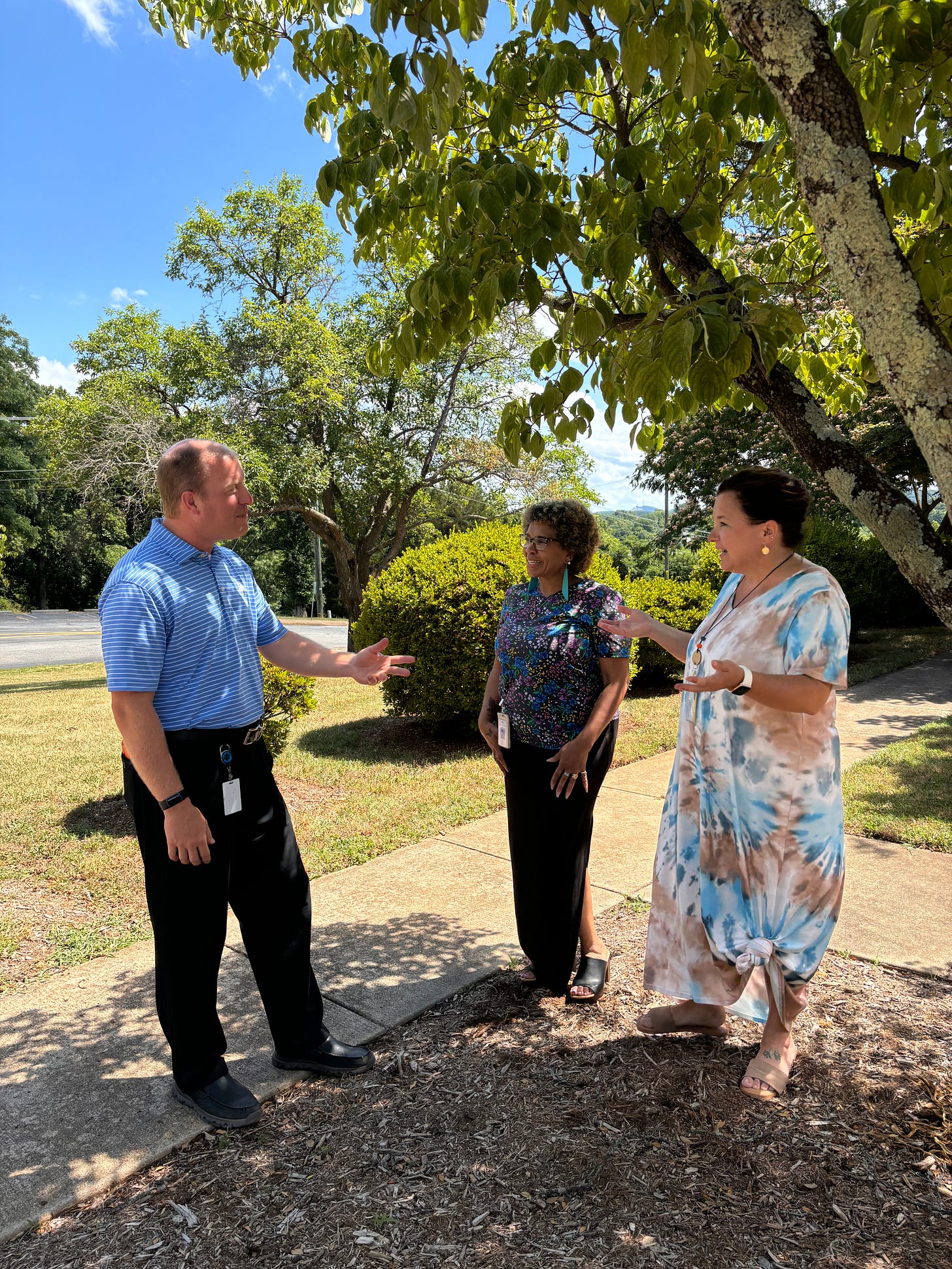Dan Hornick seeks to move OC schools from "good" to "great"
Starting his third year on the job, superintendent says post-pandemic attendance has improved significantly
In a fractious time, in a place that’s not exactly awash in funding for public education, the Orange County Public Schools got very lucky with Dr. Daniel Hornick, the superintendent of schools now in his third year on the job.
A lifelong athlete and former coach and teacher, Hornick is a study in optimism leavened with candor. In the midst of an interview earlier this summer at the Taylor Education Administration Complex, he said of the local schools, “I think we’re really good. We’re not great. And I love that challenge of trying to move from good to great.”
Hornick, 41, told me that student attendance, which had dropped so low in recent years that it was a potential state accreditation issue, is a key area where the division has seen substantial progress. When he arrived in July 2022, Orange County schools had a 38% average chronic absenteeism rate—meaning more than a third of the student body across the division had missed 18 or more days of class during the 2021-22 school year.
Students are showing up more often on Hornick’s watch and as the pandemic recedes further into the past. The Virginia Department of Education (VDOE) is due to release its annual statewide assessment reports soon, and based on the division’s attendance records, the superintendent expects Orange County’s average chronic absenteeism rate for 2023-24 to be 18-19%—a significant improvement from two years ago.
For Orange County High School, student absences have been an especially vexing problem. In 2021-22, the number of OCHS students missing 18 or more days of school was an appalling 51%. For 2022-23, that rate dipped to 36%—still high but a move in the right direction.
For 2023-24, Hornick expects further improvement for the high school. Drawing on OCHS attendance records for 2023-24, he said, “I believe we’re going to be somewhere between 28 and 29 percent.”
While OCHS is making good progress, Lightfoot Elementary School is the breakout star. Hornick said, “Two years ago, they were at 35.1%, and then in 2022-23, 17.99%. And this year [for 2023-24], we’re anticipating they’re going to be somewhere between 4 and 5%.” He credits Lightfoot’s success to teachers tutoring children who regularly arrive an hour early for school. That attention to students’ academic needs outside classroom hours, part of a state program in “high intensity” tutoring, factors into VDOE’s formula for the absenteeism rate.
I asked Hornick if he considers the pandemic the main cause of recent attendance woes. “It was the remnants of covid,” he replied. “I do believe that across the commonwealth, with virtual learning, there was almost a mindset that school is optional.”
To address the problem, he said that principals have led the way in alerting the school community that attendance is essential to achievement. He also cited teachers and administrators “doing what we can in the classroom to make kids feel welcome, to make them engaged in their learning. Those are the parts of attendance that we can control. Attendance is a tough one because we have indirect control of it, ultimately. But I think the mixture of messaging—reinforcing the importance [of attendance]—and engaging kids as much as possible is what is making the difference.”
“His leadership shines a light on our students’ path forward”
His first two years in Orange have earned him high marks from the school board. Chelsea Quintern (District 4) told me that Hornick’s “innovative leadership and deep commitment to our local community have been evident throughout his tenure. His effectiveness as a leader and his ingenuity are truly commendable.” Sandy Harrington (District 5) agreed: “His leadership shines a light on our students’ path forward by promoting educational excellence, prioritizing safety and developing a culture of responsibility, accountability, and respect here in Orange County.”

“Man, I’d really like to coach and teach”
A native of Johnstown, Pa., Hornick is an only child. When he was growing up, his mother was an instructional assistant at a local school, and his father was the third-generation owner-operator of a sporting goods store, which Hornick’s great-grandfather had opened in 1917. Hornick played football, basketball and baseball in high school and continued to play basketball while a student at Lebanon Valley College. He knew early on that he wanted to go into teaching and coaching.
“Having a few really good teachers growing up and then playing sports my whole life, I always saw myself as, ‘Man, I’d really like to coach and teach.’ And then when I went to Lebanon Valley, it was pretty clear that was what I was meant to do,” he said.
In addition to his bachelor’s degree from Lebanon Valley College, Hornick has a master’s from the University of Mary Washington and a doctorate in education from Virginia Commonwealth University. Before coming to Orange, he taught social studies and coached football, basketball and softball at Stafford High School and then moved into administration at North Stafford High School. Along the way, he completed a training program for future superintendents run by Virginia Tech.
“Don’t forget to put kids first”
I asked him if his predecessor in Orange County, Dr. Cecil Snead, had given him any advice when Snead retired and Hornick took the helm.
“[Snead’s] biggest thing was, do everything you can to take care of the good people [in the school system], and he spoke particularly about the folks at central office and the team here. And put kids first—never lose sight of the importance of what we do, which is to serve our students.
“He advised, as much as possible, be out in the buildings. If you don't have to be at central office for a particular reason, go out and engage with students, walk the hallways, shake hands with our folks doing the hard work every day in the buildings. And so that was his advice. But number one was, don’t forget to put kids first,” Hornick said.
Hornick and his wife, Stacy, and their son and daughter live in Lake of the Woods. Stacy works in Fredericksburg as the practice manager for Mary Washington Hospital’s internal medicine clinic. His son is in eighth grade and his daughter in sixth, both at Locust Grove Middle School.
The superintendent told me he and his family are happy in their new community. He was glad to say goodbye to the traffic and congestion in Stafford County and return to a small-town environment similar to what he knew growing up. His children are doing well in school, and the family has made good friends in Orange County.
Hornick is involved in local civic organizations, including the Orange Rotary Club, and loves playing golf at Lake of the Woods and other area golf courses. He also delights in watching his children play sports and talking with fellow spectators: “I really enjoy the constant interaction with community members who end up being also parents and family members and grandparents of Orange County Public Schools students.”
The school board “treats me incredibly well”
I would have been remiss if I hadn’t asked Hornick how things are going with the school board, whose members don’t always get along with each other, to put it mildly. He replied, “The group, as a collective, treats me incredibly well. I have very strong relationships with each board member…. Each, to a person, supports me.”
As evidence of that, the board unanimously granted Hornick a four-year extension on his contract and a raise. On July 1, his salary went up from $150,000 to $170,500.
Like Quintern and Harrington, Darlene Dawson (District 2) made it clear to me that she fully supports Hornick. She praised him for building relationships with many different constituencies in the community and devising creative ways to help students and recruit new teachers. Perhaps most notable, given the sometimes contentious nature of board meetings, Dawson wrote, “I have found him receptive to the ideas of others and truly willing to listen and evaluate options, even when he may disagree.”
Call it the power of optimism, of a can-do spirit. Hornick brings a much-needed unifying presence to Orange County, which he believes in so much that he calls it “a little slice of heaven.” With the school board and the community on his side, he’s determined to make that little slice better—even great.

Letter to the Editor
To the Editor:
Orange County taxpayers should support the Planning Commission’s new initiative to limit subdivisions of land in the Agricultural (A-1) zoning district to four lots of two or more acres for every 10 years of ownership.
Under current law, landowners can chop agricultural land into lots of two (or more) acres as a matter of right. So, if a developer acquires 100 acres, it might build up to 50 homes on it. This result defeats the vision statement of the county’s Comprehensive Plan: “To sustain the rural character of Orange County while enhancing and improving the quality of life for all its citizens.”
The notion of two-acre, by-right subdivision originally intended just to allow farm owners to establish family homesteads or sell outlying parcels to support their livelihoods. Nobody intended, however, that developers would twist this exception to become the rule—and turn farms into subdivisions. Indeed, Orange County stands alone—among Albemarle, Culpeper, Greene, Louisa, Madison, Spotsylvania and others—as the only county without limits on by-right developments.
Some might defend unlimited subdivisions as inherent to property rights. Developers, of course, belie their economic self-interest with this viewpoint. But ironically, many citizens defend developers’ interests—even though taxpayers suffer the quality-of-life fallout and runaway tax increases to support the schools, infrastructure, and services attendant to unbridled growth. Most people choose to live in Orange rather than (say) Loudoun County because we want “this” instead of “that.” Subdivision limits can ensure “the quality of life for all [Orange County] citizens” over the profits of a few absentee developers.
Please contact the planning commissioners and supervisors to voice your support for keeping Orange County rural.
Kevin Passerello, Gordonsville, Va.
Artist’s Loft
Our featured artist is Catherine Hillis, a painter who has exhibited widely and taught art in the U.S. and abroad. On her website, the Lake of the Woods resident writes, “My paintings can be described as traditional landscapes, still lifes and figures, but I try to use my unique perspective to draw the viewer into the world as I see it, incorporating humor or beauty whenever possible in unexpected places.… Throughout my career, I have admired, studied and found inspiration in past masters of my medium: Winslow Homer, who tells stories with paint, John Singer Sargent with his marvelous technical ability, Edward Hopper and his brooding landscapes, and the masterful Andrew Wyeth.”

Catherine’s commentary
I took many photographs of this scene when I was in Ireland last fall. I went to a well-known bar in Dublin, enjoying a Guinness, imagining how I would later paint the scene. That’s how a painting in my studio usually begins—with a quiet moment in time.
Bar scenes are one of my favorite topics to paint because there’s usually a narrative there, along with rich color and reflections. I often paint en plein air (outdoors), but because of the complexity of this scene, I created it in the studio.
I always begin with design studies first in a 5x7-inch sketchbook. Once I’ve established a successful design, I begin a complex drawing on paper. Sometimes, the drawing takes longer than the actual painting process. Once I began this piece, I applied many layers of rich watercolor paint, drying each layer, one at a time. Most people don’t realize that watercolors can be built up with an infinite number of layers of paint.
The actual work on this piece took about a week, but then it stayed on the wall in my studio at Lake of the Woods for about a month while I tweaked it. Studio paintings can sometimes take me years before I’m satisfied, but I admit that when everything is proceeding perfectly, and I make no mistakes, even a complex painting can go quickly.
People often ask me, “How long does it take to complete a painting?” The truth is, it’s taken me decades to get to the point where I am today. So, in the end, “Conversation In An Irish Bar,” has taken me about 40 years of work. —Catherine Hillis, catherinehillis.com
Local obits
Anne Meade Faulconer, 87, of Orange; Marilyn Johnson Williams, 71, of Locust Grove; Robert George Davies, 87, of Orange; Linwood K. Crawford Jr., 84, of Gordonsville, and George William Turton, 91, of Lake of the Woods.
In case you missed it
Lawsuit keeps massive Wilderness Crossing project on hold (Aug. 13, 2024)
The Arts Center's Ed Harvey rides out the culture wars (Aug. 5, 2024)
Dam right … or wrong? Fishy plans in Rapidan (June 9, 2024)



Had not heard about Hornick's contract extension. Good news. Was worried the current Board narrow majority would push him out just like the conservative ones in Hanover and Bedford counties recently did to their superintendents
Love the 🧑🎨 artist loft! What a great way to share positive community news.